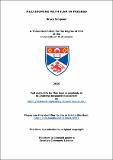Files in this item
Multihoming with ILNP in FreeBSD
Item metadata
| dc.contributor.advisor | Bhatti, Saleem Noel | |
| dc.contributor.author | Simpson, Bruce | |
| dc.coverage.spatial | 256 | en_US |
| dc.date.accessioned | 2016-04-26T14:34:16Z | |
| dc.date.available | 2016-04-26T14:34:16Z | |
| dc.date.issued | 2016-06-21 | |
| dc.identifier | uk.bl.ethos.685061 | |
| dc.identifier.uri | https://hdl.handle.net/10023/8681 | |
| dc.description.abstract | Multihoming allows nodes to be multiply connected to the network. It forms the basis of features which can improve network responsiveness and robustness; e.g. load balancing and fail-over, which can be considered as a choice between network locations. However, IP today assumes that IP addresses specify both network location and node identity. Therefore, these features must be implemented at routers. This dissertation considers an alternative based on the multihoming approach of the Identifier Locator Network Protocol (ILNP). ILNP is one of many proposals for a split between network location and node identity. However, unlike other proposals, ILNP removes the use of IP addresses as they are used today. To date, ILNP has not been implemented within an operating system stack. I produce the first implementation of ILNP in FreeBSD, based on a superset of IPv6 – ILNPv6 – and demonstrate a key feature of ILNP: multihoming as a first class function of the operating system, rather than being implemented as a routing function as it is today. To evaluate the multihoming capability, I demonstrate one important application of multihoming – load distribution – at three levels of network hierarchy including individual hosts, a singleton Site Border Router (SBR), and a novel, dynamically instantiated, distributed SBR (dSBR). For each level, I present empirical results from a hardware testbed; metrics include latency, throughput, loss and reordering. I compare performance with unmodified IPv6 and NPTv6. Finally, I evaluate the feasibility of dSBR-ILNPv6 as an alternative to existing multihoming approaches, based on measurements of the dSBR’s responsiveness to changes in site connectivity. We find that multihoming can be implemented by individual hosts and/or SBRs, without requiring additional routing state as is the case today, and without any significant additional load or overhead compared to unicast IPv6. | en_US |
| dc.language.iso | en | en_US |
| dc.publisher | University of St Andrews | |
| dc.rights | Attribution-ShareAlike 4.0 International | * |
| dc.rights.uri | http://creativecommons.org/licenses/by-sa/4.0/ | * |
| dc.subject | Multihoming | en_US |
| dc.subject | ILNP | en_US |
| dc.subject | FreeBSD | en_US |
| dc.subject | Internet | en_US |
| dc.subject | Internet architecture | en_US |
| dc.subject | Computer networking | en_US |
| dc.subject | Telecommunications | en_US |
| dc.subject | Network routing | en_US |
| dc.subject | Identifier-Locator Split Architectures | en_US |
| dc.subject | Identifier-Locator Network Protocol | en_US |
| dc.subject | Internet Protocol | en_US |
| dc.subject | IPv6 | en_US |
| dc.subject.lcc | TK5105.52S5 | |
| dc.subject.lcsh | Computer network architectures | en_US |
| dc.subject.lcsh | Computer network protocols | en_US |
| dc.subject.lcsh | FreeBSD | en_US |
| dc.subject.lcsh | Routing (Computer network management) | en_US |
| dc.title | Multihoming with ILNP in FreeBSD | en_US |
| dc.type | Thesis | en_US |
| dc.contributor.sponsor | Cisco Systems, Inc. | en_US |
| dc.type.qualificationlevel | Doctoral | en_US |
| dc.type.qualificationname | PhD Doctor of Philosophy | en_US |
| dc.publisher.institution | The University of St Andrews | en_US |
The following licence files are associated with this item:
This item appears in the following Collection(s)
Except where otherwise noted within the work, this item's licence for re-use is described as Attribution-ShareAlike 4.0 International
Items in the St Andrews Research Repository are protected by copyright, with all rights reserved, unless otherwise indicated.


